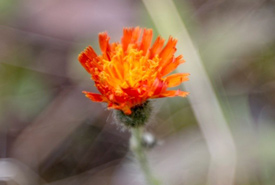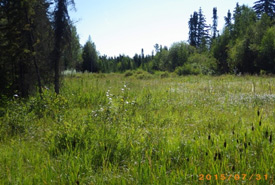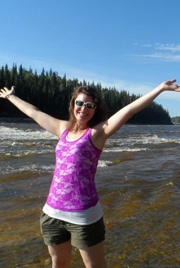What's a weed?

Orange hawkweed (Photo by Kyle Meller/ NCC)
In the world of conservation, a weed is thought of as any plant growing where it should not be, otherwise known as a non-native, or invasive, plant. Many plants can fit the description of a weed, from the nuisance dandelion to the native stinging nettle.
Merriam-Webster defines a weed as "a plant that is not valued where it is growing and is usually of vigorous growth; especially one that tends to overgrow or choke out more desirable plants."
Here at the Nature Conservancy of Canada (NCC), instead of becoming overwhelmed by the overabundance of "weeds" on our properties, we focus on those legally designated as noxious or prohibited noxious. This terminology can be confusing, as the word noxious brings to mind poison.
Most of these "noxious weeds" do not pose a threat to our health; they pose a threat to the health of native ecosystems. In fact, many of our weeds are wolves in sheeps' clothing. Take orange hawkweed, for example: a beautiful orange flash of colour; a small burning flame in the sea of green. Yet given the opportunity, it will spread with rhizomes similar to those of strawberry plants and choke out all native species.
While I describe much of my summer work with NCC as frolicking in nature, it is easy to become disheartened by the abundance of weeds on even the most protected of sites. But rather than crumble under the pressure, this summer I donned my field gear, armed myself with a GPS and a weed guide and went into battle.
The fight is easiest when the enemy can be spotted. July sets the stage for the main skirmish, when yellow, orange, purple and white flowers dot the landscape. It becomes the ideal time for reconnaissance combat by mapping the weed populations.

Perennial sow thistle. (Photo by Emily Kabotoff/ NCC)
By identifying the location of the problem area in following years, the battle continues by whittling down the plants' defenses. The Clifford E. Lee Nature Sanctuary has been the site of an annual Canada thistle pull for the past 10 years. Thanks to the annual pulls, the root reserves of the weed have dwindled; causing a notable decrease in the amount of Canada thistle.
Pulling weeds can be a great way to release frustration. After spending day in and day out mapping weed locations, it can be almost therapeutic to actually do something about the weed populations — even if that means getting down on your knees and ripping the plants from the ground.
While there’s no denying flowers certainly bring colour and life to an area, whether a front lawn or a lakeshore, not all flowers are good for the health of our native plants. So I invite you to join the fight. Know which "weeds" to look out for. Avoid planting them in your home garden. Choose native alternatives instead, such as those illustrated here.


